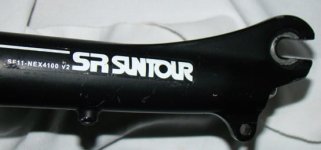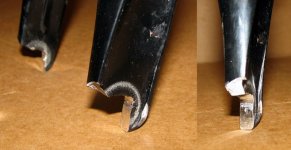You are using an out of date browser. It may not display this or other websites correctly.
You should upgrade or use an alternative browser.
You should upgrade or use an alternative browser.
Issues with front hub motor on aluminum shocks.
- Thread starter jcool3
- Start date
Drunkskunk
100 GW
If I had a dollar for everyone who has asked this question, been told it's a bad idea, decided to try it anyway, and then come back to post how they had broken their fork, I'd be be able to buy a Zero FXS.
If I had a dollar for everyone who's asked, been told No don't do it, decided to try it anyway, and then never returned to post anything again, I be buying the Zero with blood money.
It's a bad idea. Sometimes it works fine. With a low powered motor and getting the install right every time to remove the wheel, it will work without problems. Get things a little wrong, and most motors have enough power to twist in the dropouts. Aluminum, especially the cast aluminum used in cheap suspension forks tends to crack and break off when that happens, leaving you very suddenly with no front wheel. Losing your front wheel is a very painful way to crash.
If I had a dollar for everyone who's asked, been told No don't do it, decided to try it anyway, and then never returned to post anything again, I be buying the Zero with blood money.
It's a bad idea. Sometimes it works fine. With a low powered motor and getting the install right every time to remove the wheel, it will work without problems. Get things a little wrong, and most motors have enough power to twist in the dropouts. Aluminum, especially the cast aluminum used in cheap suspension forks tends to crack and break off when that happens, leaving you very suddenly with no front wheel. Losing your front wheel is a very painful way to crash.
MadRhino
100 GW
The trick when breaking a fork, is to keep the eyes on your front wheel. It will end up behind so you will roll to your ass, instead of digging the trail with your face.
Just in case you persist with the idea, and to make sure you can come back to tell us. :wink:
Just in case you persist with the idea, and to make sure you can come back to tell us. :wink:
Benjamin Wassink
1 mW
- Joined
- Apr 21, 2018
- Messages
- 11
jcool3 said:My other bike has a rear hub motor and it is such a complete hassle to change flats!
Learn to repair a flat with the wheel inside the frame! :wink:
Yeah i understand that for a new tube you need the wheel to come out the frame...
jcool3
100 mW
have done that, still a major hassle ....Benjamin Wassink said:jcool3 said:My other bike has a rear hub motor and it is such a complete hassle to change flats!
Learn to repair a flat with the wheel inside the frame! :wink:
Yeah i understand that for a new tube you need the wheel to come out the frame...
Stu Summer
100 W
I had a cheap, cast aluminum suspension fork break with a rear hub motor. Wasn't even going fast. Just not strong.
wturber
1 MW
jcool3 said:have done that, still a major hassle ....
Yep. That's why I've made my rear tire more puncture resistant. Given that I already have a rear hub motor, that seemed to be the simplest and least expensive approach.
John in CR
100 TW
I snapped both AL fork dropouts in the first meter of my first hubmotor ride. Luckily my dual torque arms kept the wheel on the bike and avoided the face plant.
Flats are a pain on a hubmotor whether on the rear or not, so I switched to moto tires a decade ago and would never go back.
Flats are a pain on a hubmotor whether on the rear or not, so I switched to moto tires a decade ago and would never go back.
Voltron
1 MW
jcool3
100 mW
Voltron said:a0bbyp.jpg
brokenfork.jpg
Here's 2000 words worth of pictures...
Did these have torque arms?
jcool3
100 mW
Unfortunately I went thru an episode with 3 flats within a week on my rear hub motor wheel. Finally figuring out that the xlm thorn resistant tubes were defective .... the presta valves were leaking at the base which was impossible to fix.wturber said:jcool3 said:have done that, still a major hassle ....
Yep. That's why I've made my rear tire more puncture resistant. Given that I already have a rear hub motor, that seemed to be the simplest and least expensive approach.
Voltron
1 MW
Re torque arm, not sure, but many I've heard of had them, and still broke off the dropout tips, but at least had the wheel stay semi attached to the fork.
I've had bad luck with extra thick Prestas, the stem attachment area is so small it rips off easily, esp if the air is a little low to where the tire creeps around the rim during hard braking. Maybe drill your rim for Schrader valve if the rim is wide enough?
I've had bad luck with extra thick Prestas, the stem attachment area is so small it rips off easily, esp if the air is a little low to where the tire creeps around the rim during hard braking. Maybe drill your rim for Schrader valve if the rim is wide enough?
MadRhino
100 GW
When you build a bike, the tires and puncture proofing are way lower in the priority list, than making a rear wheel mount that is planned for quick servicing.
Pinch dropouts are simple and safe, quick and easy.
Not applicable for all frames, bolt-on through axle dropouts are also very quick to service.
Pinch dropouts are simple and safe, quick and easy.
Not applicable for all frames, bolt-on through axle dropouts are also very quick to service.
wturber
1 MW
jcool3 said:Unfortunately I went thru an episode with 3 flats within a week on my rear hub motor wheel. Finally figuring out that the xlm thorn resistant tubes were defective .... the presta valves were leaking at the base which was impossible to fix.
Yup. My most recent flat was a presta valve base failure. But that was on the front wheel. I'm at about 3500 miles without a flat on the rear now. I've had no rear flats since I went with the "tire inside a tire" scheme.
jcool3
100 mW
these were all presta valve. My first blow out, the presta valve was gone so I had no idea what was going on. The second leak occured during installation. I took off the wheel, put in a new presta valve tube and it started leaking immediately. The thirdwturber said:jcool3 said:Unfortunately I went thru an episode with 3 flats within a week on my rear hub motor wheel. Finally figuring out that the xlm thorn resistant tubes were defective .... the presta valves were leaking at the base which was impossible to fix.
Yup. My most recent flat was a presta valve base failure. But that was on the front wheel. I'm at about 3500 miles without a flat on the rear now. I've had no rear flats since I went with the "tire inside a tire" scheme.
install I rode for a couple days and then flat .... leaking presta valve. Those were xlm thornproof tubes from Random Bike Parts.
Thinking of going to a mid motor instead of front or rear hub motors.
markz
100 TW
Justin rode across Canada with a front 500W hub.
https://youtu.be/oCvo6ffWRdE?t=272https://youtu.be/oCvo6ffWRdE?t=272
https://youtu.be/oCvo6ffWRdE?t=272https://youtu.be/oCvo6ffWRdE?t=272
wturber
1 MW
markz said:Justin rode across Canada with a front 500W hub.
https://youtu.be/oCvo6ffWRdE?t=272https://youtu.be/oCvo6ffWRdE?t=272
... and a non-suspension steel front fork. :^)
jcool3 said:the presta valves were leaking at the base
Failure at the base of the stem usually means the pressure was too low, so the tube and tire was able to move around the rim, which tears the stem at the join with the tube.
You don't see the movement in a presta tube (cuz it's fixed to the rim by the nut), but you can easily see it in a typical schrader tube (the stem looks tilted in the valve hole).
wturber
1 MW
amberwolf said:jcool3 said:the presta valves were leaking at the base
Failure at the base of the stem usually means the pressure was too low, so the tube and tire was able to move around the rim, which tears the stem at the join with the tube.
You don't see the movement in a presta tube (cuz it's fixed to the rim by the nut), but you can easily see it in a typical schrader tube (the stem looks tilted in the valve hole).
That's possibly what happened. I drilled the rim out and am now running Schrader on the front. It was dumb that I had presta on the front and Schrader on the back to begin with. Really dumb actually.
Nothing really dumb about using two different types, though it means having to carry two kinds of spare tube (unless you carry two presta, or two schrader and a drill  ).
).
I haven't used presta in...forever (other than what came on that Trek), but I've had this happen with schrader valves numerous times, both in powered (from acceleration and braking) and unpowered wheels (from braking, mostly, sometimes on rear wheels hauling heavy loads, mostly back in pedal-only days).
So lots of observations to draw conclusions from, unfortunately.
I haven't used presta in...forever (other than what came on that Trek), but I've had this happen with schrader valves numerous times, both in powered (from acceleration and braking) and unpowered wheels (from braking, mostly, sometimes on rear wheels hauling heavy loads, mostly back in pedal-only days).
So lots of observations to draw conclusions from, unfortunately.
wturber
1 MW
Yes, but I only had a spare Schrader tube. That was actually the dumb part.
jcool3
100 mW
wturber said:jcool3 said:Unfortunately I went thru an episode with 3 flats within a week on my rear hub motor wheel. Finally figuring out that the xlm thorn resistant tubes were defective .... the presta valves were leaking at the base which was impossible to fix.
Yup. My most recent flat was a presta valve base failure. But that was on the front wheel. I'm at about 3500 miles without a flat on the rear now. I've had no rear flats since I went with the "tire inside a tire" scheme.
what size tire do you have inside and out?
wturber
1 MW
jcool3 said:what size tire do you have inside and out?
Outside is a 26X 2.0 Bontrager. Inside is the tire that came with the ebike kit wheel. I'm not sure of the size. I think it was 1.95 or 1.85. Here's a couple of pictures of what I stuff into the Bontrager. The combo is a thicker than normal tube, an anti-flat tire liner,
and the old tire with the sidewalls cut off. I use rubber cement to glue the anti-flat liner to the tube. I just use one thin coat which is just enough to keep the liner in place as I stuff the three piece sandwich into the tire. The rubber cement is flexible enough to give and let everything expand as needed when the tube is inflated.
Similar threads
- Replies
- 4
- Views
- 427
- Replies
- 10
- Views
- 437
- Replies
- 7
- Views
- 346
- Replies
- 12
- Views
- 519




